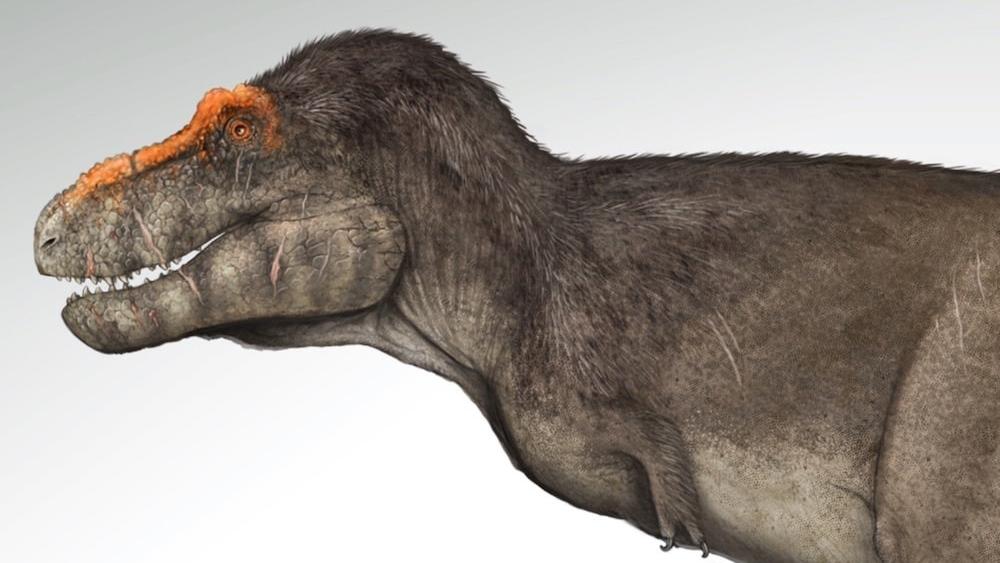Turns out, dinosaurs probably had feathers. This artist is using science to draw more accurate pictures.
Contrary to classic depictions of a tyrannosaurus rex, paleoartist Gabriel Ugueto says that the massive carnivores likely were covered in small feathers on the top of their bodies.
Gabriel Ugueto largely cultivated his lifelong fascination with dinosaurs by going to the movies as a kid. He cannot name his favorite one.
"There's nothing that looks like them today and they are so impressive. They dominated life on Earth for so long. They were so well adapted to the environment,” he says.
"I think I'm a little bit partial to theropods, which is this group of dinosaurs that are carnivorous like Tyrannosaurus and Velociraptor, but honestly it's very difficult. I love them all."
Now as an adult, Ugueto can look at the classic dinosaur movies and point out the inaccuracies of the massive creatures that called the Earth home until 66 million years ago. That’s because he has become a renowned paleoartist — a graphic artist and illustrator who takes scientific, paleontological evidence and transforms it into an image. Based on new fossil findings, these illustrations have begun to make significant changes within the last 20 years.
Take “Jurassic Park” for instance, the classic 1993 film based on Michael Crichton’s novel.
“When the original film came out, not much was wrong with it, but today, with what we know, you can say a few things,” Miami-based Ugueto says.
When people think of that movie, two types of dinosaurs may come to mind: the towering Tyrannosaurus rex — and its colossal teeth — and the lightning-quick velociraptor.
This may come as a surprise, but “T-Rex,” as most call the animal, most likely had more “prominent lips” that would have covered up its giant teeth. Furthermore, the dinosaur would have also had some sort of feather covering on the top of it, near the dorsal part of its neck, the dorsal part of its body and its trunk. Given that it lived in warmer climates and its large size, the feathers themselves may have resembled the small hairs that are found on the top of elephants, Ugueto says.
“A lot of people have this image of dinosaurs as monsters in movies, so I think when you reconstruct them with feathers some people may think that they look less scary but, I actually don't think that's the case,” he says.
There’s more. Although there was one type of the species that had the same size as the ones featured in the movie, the velociraptor — which scientifically is actually known as dromaeosaurus — was probably much smaller in size and covered head-to-toe in feathers. The Hollywood version of the creature served as an inspiration for the nickname of the then-expansion professional basketball team Toronto Raptors of the NBA in 1995. But the more accurate version?
“It would probably look more like a giant turkey,” Ugueto says, mentioning that it would still have its threatening claws and teeth. He is not a fan of the term “raptors" when talking about the species, given that biologically the term is reserved for birds of prey.
From academia to art
Ugueto began his career as a herpetologist — one who studies reptiles and amphibians — before moving onto his current job.
Although he is no longer conducting scientific research, Ugueto still reads many academic papers per year on all topics relating to his work to be able to create the most realistic depictions of dinosaurs as possible.
The sources of his color palette include relatively recent discoveries in which fossils contained preserved impressions of feathers or scales. Those samples contain melanosomes, which are structures that are responsible for animals’ color. There have also been rare instances when actual skin impressions can be used. Often, though, the colors Ugueto uses originate from several factors, such as the climate in which the dinosaur lived, what type of habitat it lived in and its suggested habits.
In addition, he takes time to monitor the behavior of the dinosaurs’ closest modern-day counterpart — birds, hence all of the feathers — and their relatives, such as crocodiles.
"I spend a lot of time in the zoo looking at birds and crocodiles to understand how they look at life themselves to understand how they behave, because more than likely dinosaurs would behave in a similar way,” he says.
Ugueto says that a majority of old-time paleoart was too centered on the dinosaurs’ bones without taking other factors into consideration.
“I think for a long time paleoart suffered from shrink-wrapping everything, skin-wrapping everything. There was no room for muscles or fat tissue. And if you look at animals alive today, you see most of the skeletal structure is hidden by the muscles and skin and fat, so you don't see much more much of the actual shape of the bone,” he says.
“So right now we're in the middle of a revolution in paleoart because a lot of artists like myself are depicting dinosaurs with what I consider is a more natural look — including room for fatty tissue, muscle and probably thinking [about] different types of integument like feathers or scales in different parts of their body.”
Want to know if a drawing of a dinosaur is historically accurate or not? Ugueto shares a trick.
“A big telltale sign is if you can see the skull shape — the exact skull shape — in the drawing of an animal that should be alive, then it's not a good drawing,” he says.
This article is from an interview that aired on PRI’s Science Friday with guest host Flora Lichtman. The original segment page contains several animated illustrations from Ugueto, as well as a complementary video.
